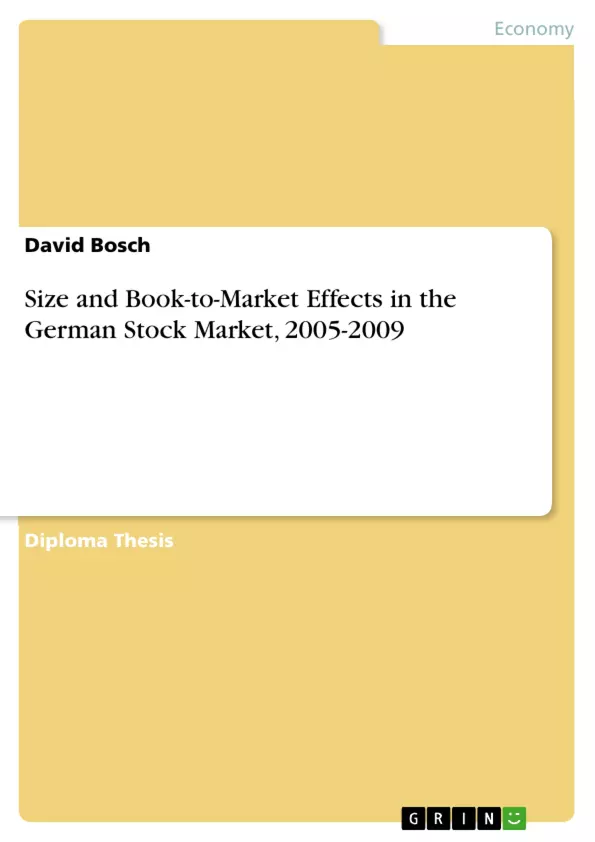One important goal of this study is to find out, whether the most recent data also shows the same tendency as earlier studies of the German market:
A very low relation between beta and average stock returns
A higher relationship between size and average stock returns
An even higher relation between B/M ratio and average stock returns.
In many studies the methodology used to test for the relationship between beta, size, B/M ratio, and stock returns are cross-sectional regressions and two-sorted portfolios. In this study, more weight is put on the ability to predict stock returns by testing these characteristics alone. Usually researchers are interested in the statistical relationship between the characteristics and stock returns. In contrast to this approach, which is especially reasonable for long-term series, this study will focus on the problems with the data and methodology of “anomaly” studies, and will discuss the different economic reasons respective to beta, size, and B/M effects in stock returns. Most of the published studies use long-term series of longer than 30 years, where the stock market returns are quite stable and only small shocks are included.
This thesis is organized as follows: In section 2, findings and economic interpretations in the literature about beta, size and B/M, are discussed. The first findings, especially about size and B/M, are briefly reconsidered and recent developments are presented and further discussed. Section 3 describes the data used for the empirical study and discusses the specialties of the data preparation used, when testing for size and B/M effects. The methodologies and results are then presented in section 4. Concluding remarks are found in section 5.
Inhaltsverzeichnis (Table of Contents)
- 1. Introduction
- 2. Literature Review
- 2.1. Size
- 2.2. Validity of the CAPM-ẞ
- 2.3. Book-to-Market
- 3. Data
- 3.1. Data Sources
- 3.2. Data Preparation
- 3.3. Data Problems
- 4. Methodology and Empirical Results
- 4.1. CAPM-B
- 4.2. Size
- 4.3. Book-to-Market
- 4.4. Cross-Sectional Regressions
- 5. Conclusions
- Appendix
- References
Zielsetzung und Themenschwerpunkte (Objectives and Key Themes)
This thesis aims to investigate the size and book-to-market effects in the German stock market from 2005 to 2009. The research seeks to determine whether these two factors significantly influence stock returns in the German market.
- Size and Book-to-Market Effects
- CAPM-Beta Validity
- Data Analysis and Empirical Results
- Cross-Sectional Regressions
- Conclusions on German Stock Market Dynamics
Zusammenfassung der Kapitel (Chapter Summaries)
The first chapter provides an introduction to the thesis, outlining its objective and scope. Chapter two reviews relevant literature on the size and book-to-market effects, exploring their theoretical underpinnings and empirical findings. This section includes a discussion on the validity of the Capital Asset Pricing Model (CAPM) and its implications for the research. Chapter three delves into the data sources, preparation, and potential problems encountered. Chapter four presents the methodology and empirical results, analyzing the relationships between size, book-to-market, and stock returns. This chapter utilizes cross-sectional regressions to provide insights into the influence of these factors on stock performance.
Schlüsselwörter (Keywords)
The key focus areas of the thesis are size and book-to-market effects, CAPM-Beta, stock returns, data analysis, cross-sectional regressions, and the German stock market. The research investigates the influence of company size and book-to-market ratios on stock returns in the German market during the period 2005-2009.
- Citar trabajo
- David Bosch (Autor), 2010, Size and Book-to-Market Effects in the German Stock Market, 2005-2009, Múnich, GRIN Verlag, https://www.grin.com/document/364783



